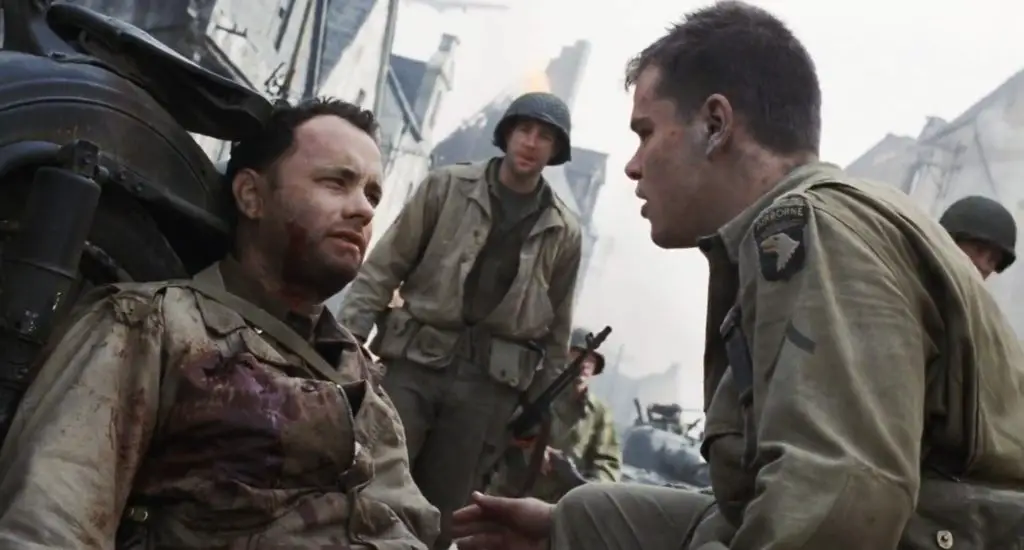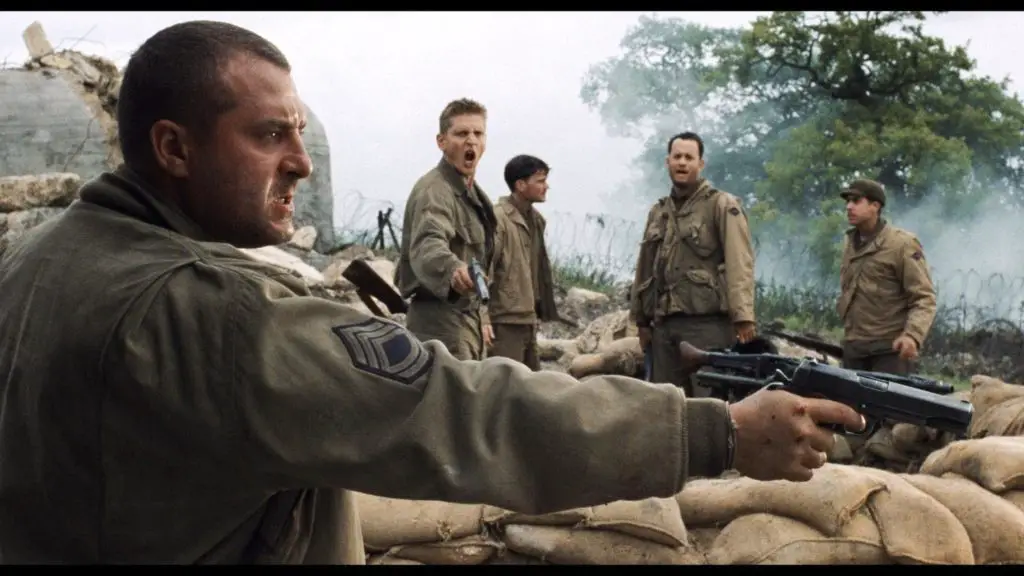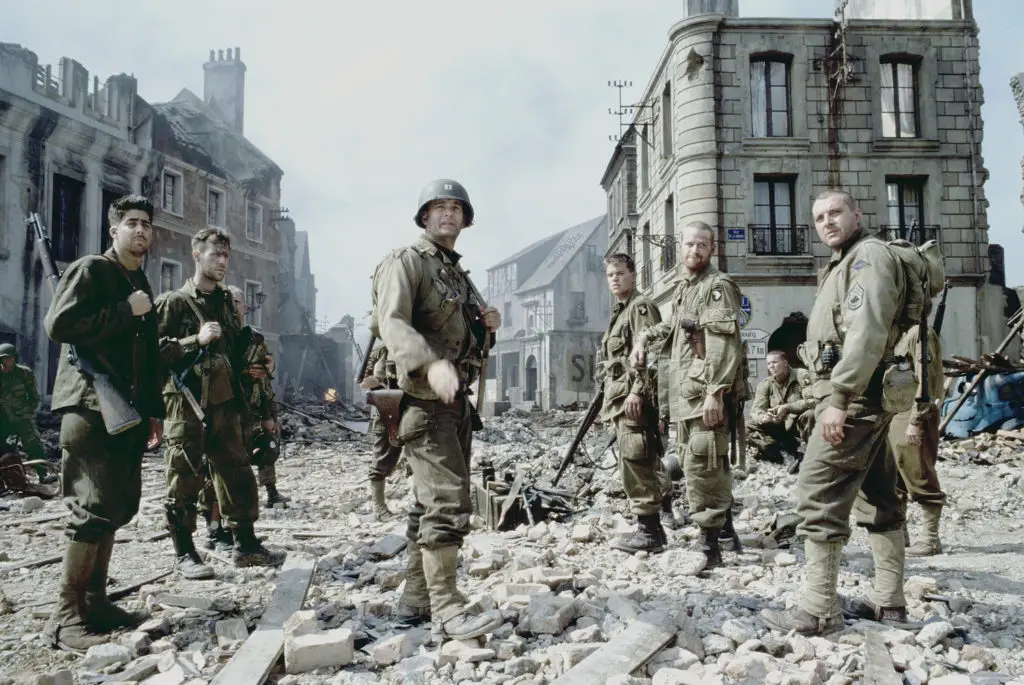A Look at the War in Saving Private Ryan. “Saving Private Ryan”: plot summary, meaning of the film, explanation of the ending, similar films.
Genre: War, Action, History
Year of production: 1998
Directed by: Steven Spielberg
Actors: Tom Hanks, Tom Sizemore, Edward Burns
tagline: “The movie that inspired to the world to remember”
Awards and Nominations: In 1999, the film won the Globe Award for Best Picture and Best Director.
Clever pictures about the war can be divided into two groups: about Tolstoy’s thoughtful senselessness of violence and about the usual soldier’s brotherhood. Analyzing the plot and meaning of the film “Saving Private Ryan” (Saving Private Ryan), it becomes clear that this tape belongs to the second category.
Most of it is death. But at the same time, this large-scale military drama shows all aspects of our existence in the conditions of world chaos.
What is the movie about
Brief description of the content of the film “Saving Private Ryan”. The picture begins with the fact that an elderly man, along with members of his extended family, comes to a cemetery where American soldiers are buried. Suddenly he starts to remember. Normandy, 1944…
After landing on Omaha Beach, American soldiers fall into the trap of German mortars and machine gunners. However, Captain John Miller, along with the surviving Rangers, manages to break through the German defense line.
 Tom Hanks played the role of Captain John Miller. Frame from the film.
Tom Hanks played the role of Captain John Miller. Frame from the film.
Soon the command in Washington finds out that four young people named Ryan are fighting at the front at once. They are all brothers and three have already died. General George Marshall decides to find the last Ryan, James Francis, a paratrooper from the 101st Airborne Division, who landed behind Nazi lines, and return him to his mother. This is not easy to do, because communication with the fighters is lost. However, the general had already given the order.
Miller was assigned to carry it out. He recruits several people into his squad and goes in search. At the very end of a dangerous mission, Miller’s squad finds Ryan. The captain informs him of the death of his brothers and orders him to prepare to be sent to the rear. However, the young man does not like this idea at all: he does not want to abandon his comrades in the face of danger. Miller understands that he cannot force him, and deep down he probably supports the guy.
Soon the Americans are attacked by the second SS Panzer Division, and they suffer heavy losses. During the battle, Captain Miller and Ryan literally fight shoulder to shoulder. Having received a serious wound, the captain tries to tell the young man that he hopes that he will live his life with dignity. Without waiting for help, he dies in front of Ryan.
Ending explanation
The explanation for the ending is quite simple: in the finale, it turns out that the elderly man in the cemetery is the same James Ryan. He came to visit the grave of Captain Miller.
Trying to hold back the oncoming tears, the old man whispers that he tried to keep the covenant of his savior – to live life with dignity.
The meaning of Saving Private Ryan’s ending is probably that all the sacrifice and deprivation that Miller and his fighters endured to save him were justified.
 Tom Hanks as John, Matt Damon as James Ryan, Edward Burns as Richard Reiben. Frame from the film.
Tom Hanks as John, Matt Damon as James Ryan, Edward Burns as Richard Reiben. Frame from the film.
Based on real events
The film “Saving Private Ryan” may seem pretentious and even, despite the constant presence of death in the frame, fabulous. However, the key to everything that happens in Spielberg’s tape lies on the surface: it is based on real events.
Indeed, during the Second World War there were such Niland brothers. Three of them died, and the US command decided to save the fourth. Yes, indeed, in the midst of the most bloody war, when human losses numbered in the hundreds of thousands, the American command really took a desperate step – to save an ordinary soldier and return him home.
American soldiers were completely unmotivated to fight the Nazis – Germany did not threaten the United States. But still they went – and contributed to the overall victory. It seems interesting that in the forties several propaganda films were released in America that convinced people that this was their war too.
It is also interesting (and symbolic) that it was the American Jew Spielberg, whose father fought at the front, who shot the two main films of the new Hollywood on the theme of the war. The first is Schindler’s List. His second painting “Saving Private Ryan” is really worthy to stand next to her.
The meaning of the film
This film, despite all its pathos, carries a philosophical meaning. The essence of the film is to save one life for the benefit of an entire nation. In this, by the way, his films and other American films about the war differ from Soviet films. Our films are about collective victory, while American films are about the victory of each individual person. In Soviet films, a feat is always generated by the collective consciousness, while in American films it is individual.
Was it worth risking the lives of several excellent fighters for the sake of “saving Private Ryan” – one ordinary soldier? In domestic films, the meaning of which is the national idea “everything for the front, everything for victory,” such a plot seems unthinkable. In Spielberg’s film, however, a completely different idea is expressed. First, there is no victory as the highest goal. And secondly, you can not abandon those who can be helped.
You can not only leave your own – you can not deprive the mother of her sons. If these ideas are unimportant and not noble, what then can be considered as such? Human life is of great value. Therefore, the mission of Captain Miller, who fought in a war that was completely unnecessary to him and his fighters, really made sense.
Steven Spielberg not only presented the audience with a spectacular and tough film about the Second World War. Like Remarque, he subtly and truthfully wrote out the living characters of ordinary people who, by the will of fate, were turned into instruments of death. In their analysis, many viewers note the psychological accuracy with which the eminent director shows through the war the desire of people for goodness, friendship and love – all this is inherent in people, and therefore indestructible.
 Frame from the film.
Frame from the film.
Thanks to this, it is impossible not to feel a spiritual kinship with people who live across the ocean – with people whom they are strenuously trying to impose hatred on us. But most of the existing contradictions are artificial …
The film “Saving Private Ryan” certainly violates the dogmatic view of the war of the domestic audience. But war cannot be a dogma. According to one interpretation, this is a disease that has nightmarish, ugly symptoms.
Spielberg introduced the American view of war to the world. However, his picture, in which, probably, one should not look for a hidden meaning, turned out to be not only pathos, but also inspiring, and formidable, and almost prophetic.
And the director’s statement can be considered not only purely American, but also international. Because it was all said sincerely and passionately. That is why the film “Saving Private Ryan” has received responses in the souls of so many people. Spielberg, in particular, managed to ensure that people who fell in love with the “soldiers’ brotherhood” of his film learned to respect the heroes of someone else’s war. In this way, they became like the US soldiers, who about 80 years ago forced themselves to fight for the “Private Ryans” in an alien and completely unnecessary massacre.
 Frame from the film.
Frame from the film.
Similar films
Here are a few pictures similar in meaning to “Saving Private Ryan”:
- Pearl Harbor (USA, 2001). Two pilot friends, in love with the same girl, live their own lives. But one day war intervenes in their peaceful life;
- The Thin Red Line (USA, 1998). A film-parable about love and human responsibility against the backdrop of the battle of the US Army rifle battalion for Guadalcanal;
- “Rage” (USA, China, UK, 2014). April 1945. Commander Wardaddy, who has extensive experience in the war against the Nazis, is trying to save the lives of his soldiers.







